| Pages:
1
..
41
42
43
44
45
..
66 |
Mailinmypocket
International Hazard
    
Posts: 1351
Registered: 12-5-2011
Member Is Offline
Mood: No Mood
|
|
Quote: Originally posted by blogfast25  | Quote: Originally posted by Mailinmypocket  | But my supplier tells me that there is still a back order on the KOH, and it will ship this week. It was supposed to ship LAST WEEK.
|
There does actually appear to be a bit of a supply problem with KOH for the moment, resulting also in a price hike... |
The KOH drought is over! The chemical fairy in a brown suit who drives a brown truck left me a gift at my door- This weekend... Hopefully will be the
weekend where I find success with this. If not then I'm puzzled...
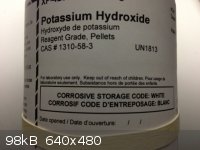 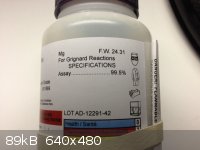
[Edited on 25-10-2012 by Mailinmypocket]
|
|
|
elementcollector1
International Hazard
    
Posts: 2684
Registered: 28-12-2011
Location: The Known Universe
Member Is Offline
Mood: Molten
|
|
So... what solvent and catalyst are you using, Mailinmypocket?
Elements Collected:52/87
Latest Acquired: Cl
Next in Line: Nd
|
|
|
Mailinmypocket
International Hazard
    
Posts: 1351
Registered: 12-5-2011
Member Is Offline
Mood: No Mood
|
|
Check earlier in this thread, I made a few detailed posts of the results I had with a few different solvents. Magnesium is believed to be the culprit
in my failures. The catalyst is t-butanol
|
|
|
UnintentionalChaos
International Hazard
    
Posts: 1454
Registered: 9-12-2006
Location: Mars
Member Is Offline
Mood: Nucleophilic
|
|
To take this in a somewhat different direction, how do you feel about using a different solvent. While drying some 1,4-dioxane (easily made from
antifreeze and sulfuric acid, but much less easily dried) with sodium, I noted that the metal was molten at the solvent's b.p. (101C) and also floats.
Potassium melts at an even lower temperature and is even less dense.
In addition, dioxane probably has at least a low solubility for KOH, being a fairly polar aprotic solvent with decent chelating powers. As an ether,
it is fairly chemically inert. If this serves to transport K+ to the Mg interface, no catalyst may be necessary. The only issue may be kinetics. If
the 200C reaction temp of the inert solvent runs is completely necessary, this approach would not work.
Department of Redundancy Department - Now with paperwork!
'In organic synthesis, we call decomposition products "crap", however this is not a IUPAC approved nomenclature.' -Nicodem
|
|
|
Mailinmypocket
International Hazard
    
Posts: 1351
Registered: 12-5-2011
Member Is Offline
Mood: No Mood
|
|
If I can get around to making more dioxane I would be willing to try... Although I think the temp needs to be around 200c.
I am determined to use the famous "baby oil" which has been reported to work previously.
Using the new reagents I tried again yesterday (didn't take as many pictures as I would have liked) but again I ran into problems that are hard to
explain.
I used the gradual addition of t-BuOH, and after the first addition of 0.6ml I noticed at least 15-20 little silver balls bobbing around and seemingly
getting bigger. After adding the entire amount of t-BuOH (1ml) and letting the reflux continue, the little balls vanished, almost one by one. After 2
hours there was nothing left.
I am not sure if this is because there is water in the system somehow, or if I am using too much t-butanol?
Will try again tomorrow after work, with a few changes to the process and see how it turns out. I am encouraged by the last crop of mini K Balls that
were floating around; if only they could stick around and conglomerate 
I just find it weird because I now know all the reagents are high quality, the baby oil used is the one shown and reported to work in nurdrage's
video- If my next attempt doesn't work, then I will need to take a break from this and research more...
The oil used for the synth
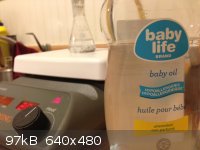
Heating started, didn't take more picture after this unfortunately, but they weren't much different from other photos
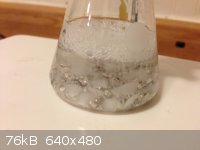
[Edited on 31-10-2012 by Mailinmypocket]
|
|
|
Fossil
Hazard to Others
  
Posts: 131
Registered: 4-4-2012
Location: Canada
Member Is Offline
Mood: No Mood
|
|
I'm assuming you had something in place to keep atmospheric moisture from getting into your reaction vessel.
I can't wait to give this reaction a try once my new lab is done. Hopefully your next attempt turns out better.
Good luck!
|
|
|
watson.fawkes
International Hazard
    
Posts: 2793
Registered: 16-8-2008
Member Is Offline
Mood: No Mood
|
|
Tert-butanol is used to dispose of excess potassium
reagent when there's likely to be excess K post-reaction. From what you described, it does seem like you might well try using less and see if that
gets your product losses under control.
|
|
|
blogfast25
International Hazard
    
Posts: 10562
Registered: 3-2-2008
Location: Neverland
Member Is Offline
Mood: No Mood
|
|
I believe the 200 C reaction temperature is indeed no something that can be dispensed. It's crucial.
Dioxane appeares to be useful to coalesce the metal, post reacion.
|
|
|
blogfast25
International Hazard
    
Posts: 10562
Registered: 3-2-2008
Location: Neverland
Member Is Offline
Mood: No Mood
|
|
Mailinmypocket:
Potassium does of course react with t-butanol to form K t-butoxide. Clearly some K did materialise but not enough and that is unusual. I would not
change the amount of catalyst used if it complies to the patent.
You’re sure about the solvent? It isn’t some grade that’s been adulterated with something?
Try deodorised kerosene as a reaction medium…
|
|
|
macbluff619
Harmless

Posts: 8
Registered: 1-7-2012
Member Is Offline
Mood: No Mood
|
|
Wow. Thanks to everyone contributing and especially those experimenting. You've taught me a lot in the thread. I've tried the fiery crucible method
(as found on youtube) and it doesn't really seem like a viable way to get a decent amount of sodium or potassium. But this really got me excited. It's
such a bummer that no one has been able to reproduce the results from versuchschemie or Nerd Rage. I have a lot of KOH but need to order a few things
before I can help out experimentally.
I read the whole thread and most of the links but maybe I missed it, has any one tried mixing solvents? The pdf below ShellSol D70 says it is about
60% paraffins (miineral oil?) 40% naphthenes (cyclohehane?).
Since ShellSol D70 and tetrahydronapthalene aren't OTC and mineral oil/baby oil by itself isn't working maybe some combination of solvents would work.
http://www.scdynamiccontent.shell.com/Files/aliphaticmineral...
|
|
|
Mailinmypocket
International Hazard
    
Posts: 1351
Registered: 12-5-2011
Member Is Offline
Mood: No Mood
|
|
Quote: Originally posted by blogfast25  | Mailinmypocket:
Potassium does of course react with t-butanol to form K t-butoxide. Clearly some K did materialise but not enough and that is unusual. I would not
change the amount of catalyst used if it complies to the patent.
You’re sure about the solvent? It isn’t some grade that’s been adulterated with something?
Try deodorised kerosene as a reaction medium…
|
I definitely will try the deodorized kerosene this weekend. I attempted the experiment again this afternoon, using the liquid paraffin baby oil one
last time, it worked!!! Ran into some confusing situations though- but I did have lots of little K balls bobbing around. I used half the original
t-BuOH as I was starting to suspect an overdose situation going on there.
I'm out now, but when I get home I will edit this post and upload all the most relevant pictures and details from my notes.
I can confirm one thing though- as Blogfast has mentioned before, the shellsol is absolutely not necessary!
[Edited on 1-11-2012 by Mailinmypocket]
|
|
|
blogfast25
International Hazard
    
Posts: 10562
Registered: 3-2-2008
Location: Neverland
Member Is Offline
Mood: No Mood
|
|
Quote: Originally posted by macbluff619  | . It's such a bummer that no one has been able to reproduce the results from versuchschemie or Nerd Rage. I have a lot of KOH but need to order a few
things before I can help out experimentally.
|
No 'bummer' here, pal. Most that have tried to replicate the method have succeeded. That includes woelen, len1, garage chemist, me and a couple of
others too. But there have been some unexplained failures of recently...
@mailinmypocket:
Great! Now 'show me the metal' 
[Edited on 2-11-2012 by blogfast25]
|
|
|
Mailinmypocket
International Hazard
    
Posts: 1351
Registered: 12-5-2011
Member Is Offline
Mood: No Mood
|
|
Alright, so I did have K for the longest time in the reaction vessel- longer than ever before. The proportions of reagents used were as follows:
-5g KOH
-2.7g Mg
-0.5ml t-butanol in 5.5ml oil (half of the amount I have used in all previous experiments)-Thanks to Watson\Blogfast for suggesting less!
-25ml of the damned hypoallergenic baby oil (which I am starting to hate)
Another difference this time is that I allowed the white fumes to escape the system during the dehydration of the KOH. When the temp hit 170c a dense
white plume of oil\water vapor shot out of the flask, strange since it is never that violent when the condenser is left on. After this event, the KOH
had become a hard structure similar to the way a silicate garden looks.
I broke apart the KOH with a glass rod, and when I rinsed it under the tap yellow sparks flew off the residue which was adhered to it! I'm assuming
this was hydrogen self igniting?
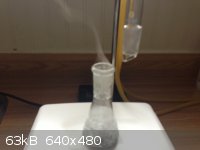 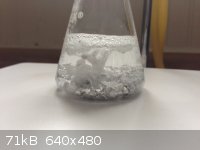
This was less than 30 seconds after adding 1/3 of the t-butanol/oil mix. Many tiny balls were floating around and in particular you can see a large
group of them as a grayish mass on the right side of the oil surface!
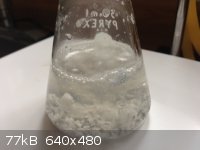
I waited about 10 minutes and added another shot of t-butanol, and about 2 minutes later the balls had grown a bit in size, and there were less of
them:
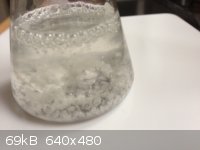
Again, 10 minutes later I added the final t-BuOH and allowed everything to reflux. The K never disappeared as it did in previous attempts and the
balls were getting bigger (albeit very slowly) This image shows one of the larger balls after 3 hours, it looks like a bubble on the lower left side
of the flask, but it is a perfectly shiny ball that looks like mercury! 
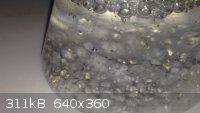
Unfortunately it somehow vanished by 3.5 hours, and I couldn't see any more K anywhere, I'm really stumped here. Im going to try with kerosene next
time because this whole baby oil thing is getting tiresome. I think it may be somehow preventing good coalescence from happening- The balls sometimes
had a waxy white appearence, as if they were coated in some soapy\waxy material, which was probably preventing them from adhering to each other.
Fossil: To answer your question, yes I am excluding air from the system once the reaction starts. I have some thin rubber sheeting from a first aid
kit that I cut to size and wrap over the condenser top with a few pin holes in it. Works awesome.
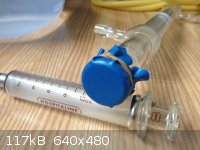
I wish there was a way I could rescue the balls before they disappear into another dimension 
[Edited on 2-11-2012 by Mailinmypocket]
|
|
|
blogfast25
International Hazard
    
Posts: 10562
Registered: 3-2-2008
Location: Neverland
Member Is Offline
Mood: No Mood
|
|
Mailinmypocket:
Although it’s all a bit unusual, your reaction is clearly proceeding. Try this: going by the 5th photo, I’d say conversion is more or less
complete by that time. At that point, stop heating. When fully cooled (RT), carefully decant off the solvent (caution: may contain small amounts of
K!!) and replace it with virgin kerosene. Now heat to about 90 C and have patience: your K will slowly coalesce (this does take TIME!).
My guess is that your reaction medium (‘baby oil’) contains a(n) additive(s). Clean deodorised kerosene should work well for you.
All in all well done!
[Edited on 2-11-2012 by blogfast25]
|
|
|
Mailinmypocket
International Hazard
    
Posts: 1351
Registered: 12-5-2011
Member Is Offline
Mood: No Mood
|
|
Quote: Originally posted by blogfast25  | Mailinmypocket:
Although it’s all a bit unusual, your reaction is clearly proceeding. Try this: going by the 5th photo, I’d say conversion is more or less
complete by that time. At that point, stop heating. When fully cooled (RT), carefully decant off the solvent (caution: may contain small amounts of
K!!) and replace it with virgin kerosene. Now heat to about 90 C and have patience: your K will slowly coalesce (this does take TIME!).
My guess is that your reaction medium (‘baby oil’) contains a(n) additive(s). Clean deodorised kerosene should work well for you.
All in all well done!
[Edited on 2-11-2012 by blogfast25] |
Thanks 
I was eager to try it again today but once again distractions came up... Eff!
As for the "baby oil" I really didn't want to try it again but I did want to rule it out and see what happened with less t-butanol and letting the
water vapor escape. I would like to try your one-pot method with odorless kerosene, but I would also like to let the water escape- I guess I could
dehydrate the KOH, cool, and then add the entire dose of t-BuOH and ramp up the heat?
Promising results! I dont think I am that far from having some K!!
|
|
|
blogfast25
International Hazard
    
Posts: 10562
Registered: 3-2-2008
Location: Neverland
Member Is Offline
Mood: No Mood
|
|
Quote: Originally posted by Mailinmypocket  |
[...] but I did want to rule it out and see what happened with less t-butanol and letting the water vapor escape. I would like to try your one-pot
method with odorless kerosene, but I would also like to let the water escape- I guess I could dehydrate the KOH, cool, and then add the entire dose of
t-BuOH and ramp up the heat?
Promising results! I dont think I am that far from having some K!! |
Remember that the water doesn’t actually ‘escape’. According to the proposed reaction mechanism (find it pages and pages upthread) the magnesium
firstly scavenges the water (mostly from the KOH which as a general rule contains about 10 % of it) acc.: Mg + 2 H2O == > Mg(OH)2 + H2. This causes
the first bubbling to occur. ALWAYS have your refluxer in place though, right from the start.
Re. ‘one pot’, it gave me good results. Nurdrage claimed greater variability with that method but didn’t provide data supporting that assertion.
But in your case, and purely for reasons of back-to-back comparison, it may be wise to simply follow patent procedure but with kero instead of baby
oil, to compare the two.
I find the one pot method so much easier though, and it avoids faffing about with this ‘timed addition’ of the catalyst. IMHO the proposed
reaction mechanism also supports that adding the required amount of catalyst right from the start should make no difference and that the ‘timed
addition’ is merely a form of chemical superstition. That’s my take on it.
[Edited on 3-11-2012 by blogfast25]
|
|
|
Nicodem
Super Moderator
      
Posts: 4230
Registered: 28-12-2004
Member Is Offline
Mood: No Mood
|
|
Not really on topic, but I would just like to correct this mistaken terminology. "One pot" synthesis is a term already in use for something totally
different, namely for multi-step syntheses applied without the isolation of the intermediates. Here you have a one-step synthesis where you changed
the procedure (timing for the t-BuOH addition). Procedural changes don't own a particular terminological phrase (because there is no need for it),
instead only a reference is used (e.g., "blogfast25's modification" or "by the procedure developed by blogfast25" or similar).
|
|
|
Mailinmypocket
International Hazard
    
Posts: 1351
Registered: 12-5-2011
Member Is Offline
Mood: No Mood
|
|
Quote: Originally posted by blogfast25  |
Remember that the water doesn’t actually ‘escape’. According to the proposed reaction mechanism (find it pages and pages upthread) the magnesium
firstly scavenges the water (mostly from the KOH which as a general rule contains about 10 % of it) acc.: Mg + 2 H2O == > Mg(OH)2 + H2. This causes
the first bubbling to occur. ALWAYS have your refluxer in place though, right from the start.
Re. ‘one pot’, it gave me good results. Nurdrage claimed greater variability with that method but didn’t provide data supporting that assertion.
But in your case, and purely for reasons of back-to-back comparison, it may be wise to simply follow patent procedure but with kero instead of baby
oil, to compare the two.
I find the one pot method so much easier though, and it avoids faffing about with this ‘timed addition’ of the catalyst. IMHO the proposed
reaction mechanism also supports that adding the required amount of catalyst right from the start should make no difference and that the ‘timed
addition’ is merely a form of chemical superstition. That’s my take on it.
[Edited on 3-11-2012 by blogfast25] |
I got the idea to release the vapor from woelen's procedure, I didn't know if it was necessary or not but today's experiment seems to indicate that it
isn't.
The experiment isn't done but I wanted to show what is going on in case I can get help before it's too late.
Same proportions of reagents as before, except I used unscented kerosene as the solvent.
First, the good old workhorse flaskseems to be getting a bit etched.. oh well, to hell with it 
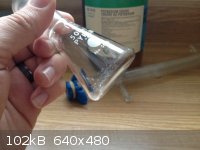
This is IMMEDIATELY after adding 1\3 of the t-butanol mix (0.5ml\5.5ml kerosene). Before I even put the syringe down i saw a bunch of K balls racing
around, awesome!
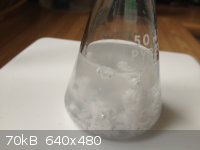
The balls, as seen from above
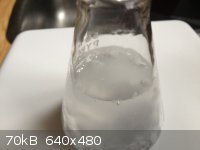
Coalescence definitely happening, haven't added any more t-butanol mix yet, this was about 5 minutes later.
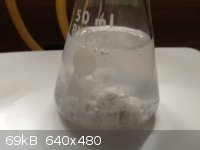
After adding the second shot of t-butanol, you can see the balls are already decreasing in size (and bubbling vigorously, is this normal or is it
excess t-BuOh reacting with them?) I am thinking that it this is the case.
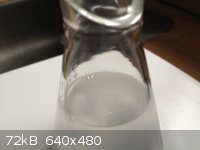
Now there is no more K to be seen, I'm thinking that 0.5ml of t-butanol is still too much- is this possible? Less than 0.25ml of t-BuOH for 2.6g Mg\5g
KOH!?
[Edited on 3-11-2012 by Mailinmypocket]
|
|
|
blogfast25
International Hazard
    
Posts: 10562
Registered: 3-2-2008
Location: Neverland
Member Is Offline
Mood: No Mood
|
|
Mailinmypocket:
It has to be said that your reagent ratios are slightly different from the original presented at Versuchschemie.
Pok used:
3.11 g Mg
6.12 g KOH
0.6 g t-butanol
50 ml solvent (Shellsol D)
You used:
2.7 g Mg
5.0 g KOH
0.5 ml t-butanol
25 ml solvent (kerosene)
The most striking difference is the amount of solvent used: you use only half the amount most of us have used. Even bearing in mind that difference,
I’m still at a loss to explain your strange results.
Am I right in guessing you’re using only 25 ml of solvent because you have only a 50 ml conical flask? If so I would suggest to try: 1.55 g Mg, 3.06
KOH, 0.3 g t-butanol and 25 ml kerosene.
Although K does react with t-butanol, the molar ratio of KOH/t-butanol is about 10. That means that about one tenth of the potassium can remain in
solution as K t-butoxide, even at the end of the reaction, but not more. Something else must cause your potassium’s disappearing act but I don’t
know what…
[Edited on 3-11-2012 by blogfast25]
|
|
|
Mailinmypocket
International Hazard
    
Posts: 1351
Registered: 12-5-2011
Member Is Offline
Mood: No Mood
|
|
Yeah, my flask sizes are a bit off, so after 50ml the next size up is 250ml (for ground glass tapers anyways).
I am currently running the reaction using the proportions you posted (after the last visible K disappeared I shut everything down- no use to reflux
for nothing), there are a few K balls on the bottom that are gradually shrinking but they were sitting there for a while, growing slowly. I don't know
anymore, I need to take a days break off this and re-evaluate the whole experiment. The experiment is not done but I'm not very hopeful for some
reason...
God, what a frustrating reaction. For the time and money spent on this I could have just bought 50-100g of K from my supplier... But that isn't the
idea, damn it!
[Edited on 4-11-2012 by Mailinmypocket]
|
|
|
elementcollector1
International Hazard
    
Posts: 2684
Registered: 28-12-2011
Location: The Known Universe
Member Is Offline
Mood: Molten
|
|
@Mailinmypocket
I notice that your K balls in pic 4 have a strikingly white color to them. I haven't done this reaction before, but I suspect water (thereby forming
KOH). Or a trick of the light. As per NurdRage's vid, the potassium goes *black* if it oxidizes too far.
Also, I have a question: I have little granules of Mg, not really a sand but close to it (roughly 1mm or less in size, spherical). Is this good for
this reaction?
Elements Collected:52/87
Latest Acquired: Cl
Next in Line: Nd
|
|
|
blogfast25
International Hazard
    
Posts: 10562
Registered: 3-2-2008
Location: Neverland
Member Is Offline
Mood: No Mood
|
|
EC1:
When it comes to magnesium, here the only thing we can say with certainty is : 'Test!'
|
|
|
Mailinmypocket
International Hazard
    
Posts: 1351
Registered: 12-5-2011
Member Is Offline
Mood: No Mood
|
|
Quote: Originally posted by elementcollector1  | @Mailinmypocket
I notice that your K balls in pic 4 have a strikingly white color to them. I haven't done this reaction before, but I suspect water (thereby forming
KOH). Or a trick of the light. As per NurdRage's vid, the potassium goes *black* if it oxidizes too far.
Also, I have a question: I have little granules of Mg, not really a sand but close to it (roughly 1mm or less in size, spherical). Is this good for
this reaction? |
In previous attempts with baby oil the balls did sometimes develop a white coating. Now in the last tries with kerosene the balls have a white
appearance because they are fizzing, from what I understand all the water gets scavenged by the magnesium during the initial heating(forming Mg
hydroxide)
I've never had them turn black as was shown in nurdrages video, they simply get smaller and disappear. Perhaps the darkening is something that happens
with tetralin? You magnesium should be fine- as long as it is clean and shiny, not coated in oxide crap for "safety" like the Mg I used previously!
Right now I'm using turnings intended for grignards and it works.
|
|
|
blogfast25
International Hazard
    
Posts: 10562
Registered: 3-2-2008
Location: Neverland
Member Is Offline
Mood: No Mood
|
|
The blackening seems to point to superoxides forming, as anyone who has stored potassium under kerosene will have witnessed (the only way to keep the
metal clean and shiny is to store it in oxygen free glass ampoules, otherwise the superoxides inevitably forms over time. They’re also quite
dangerous!)
|
|
|
elementcollector1
International Hazard
    
Posts: 2684
Registered: 28-12-2011
Location: The Known Universe
Member Is Offline
Mood: Molten
|
|
Where did the oxygen come from? I don't suppose the K metal stole it back from the magnesium, resulting in an oxygen-theft war between the two.
So, in other words, everything has to be bone-dry (short of KOH, for obvious reasons) to work?
The magnesium I have on hand is a silvery color, and burns quite well. Alternatively, I have those beautiful ribbon-shaped turnings from drilling into
a camping firestarter (at least 95% Mg).
Having major problems sourcing OTC or even online tert-alcohol. Thoughts?
Elements Collected:52/87
Latest Acquired: Cl
Next in Line: Nd
|
|
|
| Pages:
1
..
41
42
43
44
45
..
66 |